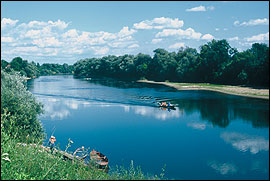 |
Sava Commission a model of sub-basin cooperationThe Sava Commission officially opened to exchange information, and to eliminate or reduce trans-boundary impacts on the Sava River Basin, which holds the largest volume of water for a sub-basin in the Danube region. |
 |
The Sava runs 946 km
from west to east
beginning in Slovenia and
ending at its confluence
with the Danube in
Belgrade. The Sava Basin
holds the largest volume
of water for a sub-basin
in the Danube Basin,
contributing about 25%
of its total discharge and
covering 96,400 sq km or
15% of the Danube Basin. |
On July 5, the Office of the International Sava River Basin Commission was officially opened in Zagreb, Croatia. The new commission is mandated with implementing the 'Framework Agreement for the Sava River Basin' (FASRB) on behalf of the Sava Basin States including Bosnia and Herzegovina, Croatia, Serbia and Montenegro, and Slovenia. The FASRB was the first regional agreement since the Dayton Peace Agreement ended the war in the former Yugoslavia in 1996.
Setting standards for cooperation.
"I am very optimistic regarding the future work of the Sava Commission
and its results in accomplishing agreement goals," said Commission
Chairman Kemal Karkin."This is not going to be easy because, unlike
other river basins, this basin has to pass through a recovery phase due
to the effects of the war. However, since all parties of the Agreement expect
implementation of initial goals and benefits in the near future, we will
try to implement both the recovery phase and development phase at the same
time and in all areas of transboundary cooperation treated by the agreement.
For this purpose I expect technical and financial support from donors and
international financial institutions, as well as fruitful cooperation with
other international organizations, especially with the ICPDR and Danube
Commission."
Improving waterways together.
One of the Commission's main tasks will be the development of a 'Pragmatic
Sava River Basin Management Plan' in line with the EU Water Framework Directive.
Supported by the UNDP/GEF Danube Regional Project, the process will include
an analysis of the major transboundary issues related to water quality control
and water management in the basin, and a programme of measures to deal with
them including new policies, laws and investments by international and bilateral
donors.
Under the FASRB, the Sava Basin states agreed to cooperate in the integrated
management of surface and ground water resources, including having a sufficient
quantity and quality of water to protect, preserve and improve aquatic systems,
and protect against the harmful effects from water. Considerable emphasis
in the agreement relates to parties maintaining and improving navigation,
and for the Commission to provide financing for the construction of new,
navigable waterways.
Filling local needs.
The OSCE has been significantly involved in providing political and technical
support in the lead-up to the Sava Commission. It is now helping to develop
a network of local actors in the Sava Basin including local authorities,
water suppliers and NGOs. "There is no mechanism to link local input
with the Commission", says the OSCE’s Raul Daussa. "The new network
will inform the Commission of the real needs and concerns of the end users
of water - for example, if a municipality requires a new pumping facility,
the Commission will know about it."